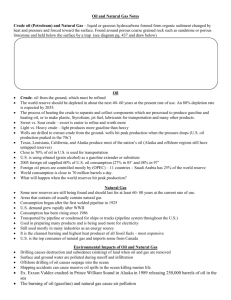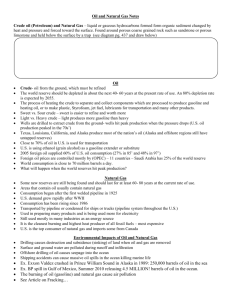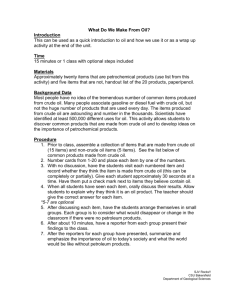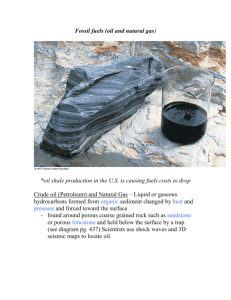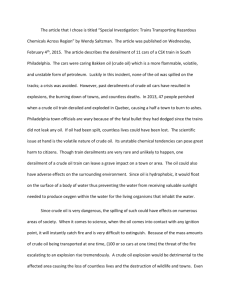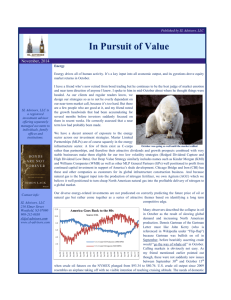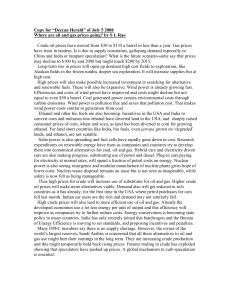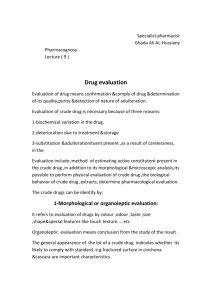The Determination of Demand for crude oil in the US.
advertisement
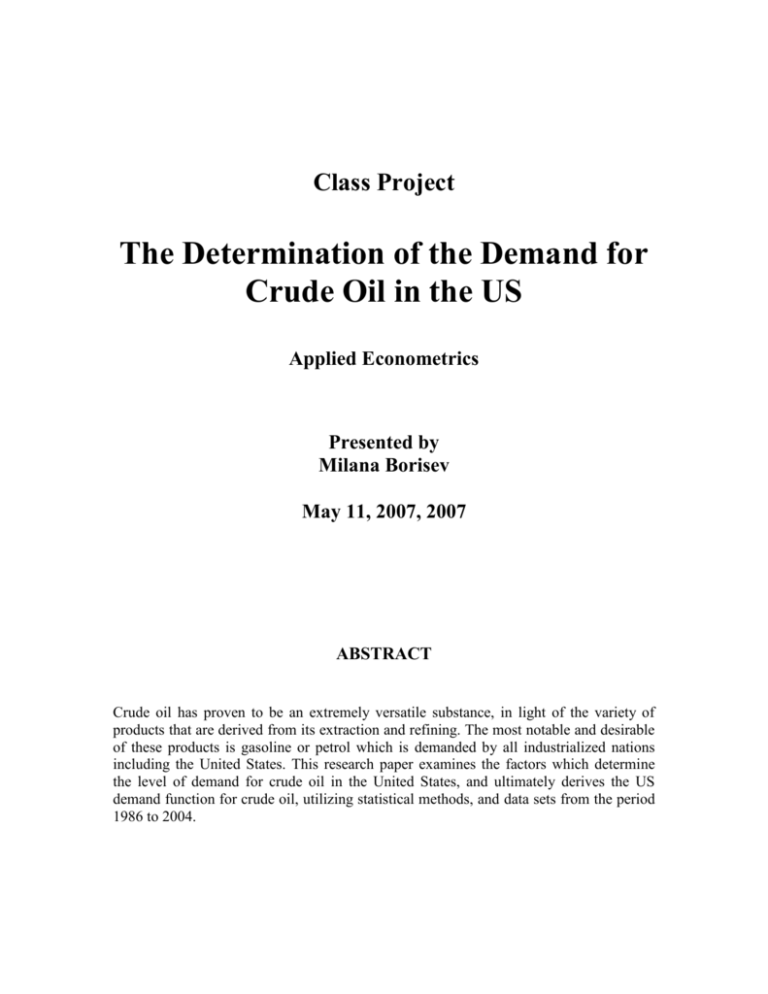
Class Project The Determination of the Demand for Crude Oil in the US Applied Econometrics Presented by Milana Borisev May 11, 2007, 2007 ABSTRACT Crude oil has proven to be an extremely versatile substance, in light of the variety of products that are derived from its extraction and refining. The most notable and desirable of these products is gasoline or petrol which is demanded by all industrialized nations including the United States. This research paper examines the factors which determine the level of demand for crude oil in the United States, and ultimately derives the US demand function for crude oil, utilizing statistical methods, and data sets from the period 1986 to 2004. 1. Statement of the problem. Crude oil products play a critical role in industry; producing energy to propel vehicles, power turbines and heat factory facilities. In addition, crude oil by- products form the basis of the petrochemical industry in which plastics are manufactured. The versatility of crude oil has led to its consumption in a variety of sectors and demand is often categorized and analyzed according to each sector. These sectors include: Transportation Sector: For use in cars, trucks, buses, trains and airplanes Non-Transportation Sector : Manufacturing, Residential and Service The consumption of crude oil has grown significantly over the past decade. Since 1995 world oil consumption increased from 70.0 to 82.4 million barrels per day (bpd).1 While many attribute this dramatic increase in demand to increased economic activity in China and India, increased crude oil demand has originated from both Organization of Economic Developing Countries (OECD) and Non-OECD countries. OECD countries oil use from 1995 through 2004 rose almost 5 million bpd while Non-OECD use grew more quickly, expanding by 7.7 million bpd. China represented only 39% of this non-OECD growth. 2This is an interesting question to study because crude oil and its consumption, as I mentioned in previous paragraph, play very important role in variety of sectors. The reason that really motivated me to this research is that I wanted to estimate what effect price change has on demand for crude oil. The United States has also seen an increase in consumption between 2003 and 2004 from 20 million to 20.4 million with the largest consumption being attributed to gasoline within transportation sector. This leads to the purpose of this research paper which is to derive the demand function for crude oil in the United States. United States is one of the most developed countries in the world where consumption of crude oil and its products fall in the group of necessities. Under this assumption I will test to see what factors derives the US demand function for crude oil, utilizing statistical methods, and data sets from the period 1986 to 2004. 1 2 Energy Information Administration: This week in petroleum 1998. Energy Information Administration; International Energy Outlook 2006. 2 Review of Literature Crude oil is one of the most important sources of energy and also represents about 41% of primary energy consumption worldwide. Crude oil is also used as raw material for the photochemical industry all over the world. Since 1971 world crude oil consumption increased for around 46 percent, and of this total United States of America currently consumes just 25 percent. Also, over the 30 year, from 1971-2001, world crude oil consumption increased by 46%. One of the things that caused this high percentage increase in demand for oil and also strong incentive for the more efficient use of oil, are new improvements in technology and also world wide developments. The average annual rate of growth of oil consumption according to Cooper’s results (2003) has grown at the slower rate than the real GDP, which means that the rate of oil consumption in the production of GDP has declined. Cooper used econometric estimates to determine the price elasticity in short and long term. The results that he came up with are saying that the price elasticity is very low in both the long and the short run. The long run price elasticities of demand for the United States is at -0.56, while the short –run price elasticity was estimated at -0.08.From the results of the Coopers paper we can conclude that in the short-run demand for the crude oil is highly price inelastic, and on the other hand demand for the crude oil in a long-run is somewhat less price inelastic. A Paper written by Castello (2006) is estimating whether changes in prices of petroleum and (crude oil, motor gasoline), affect the demand for petroleum. One other thing that he is estimating is short term demand elasticity’s relative to price changes. The results that he came up with are that in short-term petroleum elasticity’s with respect to price are small (demand is inelastic), and a reason for this is limited substitution possibilities in the short term. Domestic petroleum consumption is expected to decline or increase by about 0.4 percent for every permanent increase or decrease the price. 3 Both of the papers written by Cooper( 2003) and Castello( 2006) are getting the same results about demand elasticity’s relative to price changes. The effect of changes in price and income level on oil demand is well explained in the model estimated by Gately and Huntington (2001). They examine the asymmetric effects on demand of decreases and increase in income and price levels and also the different speeds of demand adjustments to changes in price and income. The results that they came up with include the 96 world’s largest countries but they also estimated the separate results for the US. The demand for the crude oil responds much more to increases in oil prices than to decreases and the speed of demand which lead us to asymmetric price response which is graphed on figure 1.4 The demand reduction in 1971 and 1973 was caused with the high oil price increase were not reversed by the oil price 3 Dave Costello , May 9,2006. Reduced Form Energy Model Elasticities from EIA’s Regional Short –Term Energy Model (RSTM) Figure 1 Source: Dermont Gately and Hillard G. Huntington, August 2001: “The Asymmetric Effects of Changes in Price and Income on Energy and Oil Demand” ,page 5. 4 3 decrease in 1981-1986.As we could see from the figure1 that the demand responses to increase in prices are not reversed when prices fall. Also one other result that they came up with is that the demand effects of changes in income are not always perfectly reversible which we could also see from the price changes responds of demand. US average annual income growth rate is around 2% and oil demand growth rate is about 1%, which is showing that demand growth rate is lower that the growth rate in income. Crude oil demand, according to Gately and Huntington (2001), has responded more to increases in income than to decreases in income. The bottom line of this paper is that demand has responded more to increases in income than to decreases in income level and price, and also that even if there is increase in income level there could still be decrease in demand for crude oil caused by increase in price of crude oil. From the previous two papers we could see that the demand for the crude oil is mostly determined by the price and income levels. I would like to review the paper that is estimating the relationship between the price of crude oil and the real GDP levels (Guo, Kliesen, 2005). As we could see from previous papers, there were large price movements in crude oil since the World War II. One of the explanations is that oil price increases cause GDP growth to decrease by raising production costs. Oil price volatility has a negative and marginal effect on future GDP growth when combined with oil price changes5. 5 Hui Guo and Kevin L. Kliesen, November/December 2005; Federal Reserve Bank of St. Louis Review: “Oil Price Volatility and US Macroeconomic Activity”. 4 Figure 1 Figure 1 Source: Dermont Gately and Hillard G. Huntington, August 2001: “The Asymmetric Effects of Changes in Price and Income on Energy and Oil Demand” ,page 5. 2. Formulation of the Model A demand function can be described as how much of a good will be purchased at alternative prices of that good and related goods, alternative income levels and alternative values of other variables affecting demand. 5 This paper derives a linear demand function for crude oil in the US, which will take a form similar to the equation below: Consumption = β0 + β1 price + β2 rgdp+ β3 avmicars + β4 avmibuss + ei The dependent variable: annual consumption of crude oil (thousand barrels per day) Theoretical justification of right hand side regressors: β1: average annual crude oil price (2003 constant dollars per barrel) (Inverse relationship with dependent variable- as price increase, demand decrease) β2: real GDP per capita in actual 2003 dollars (Direct relationship with dependent variable-higher real income level, purchasing power increase) β3: Average annual miles per vehicle- cars (1,000) (Directly proportional with dependent variable- as average annual miles per vehicle increase so does the demand for oil) β4: Public Transportation miles of travel –busses (billions) (Negative effect on dependent variable because as public transportation increase there would be less demand for oil for end use) Regression analysis would be used to derive a function similar to the above for the US consumption of crude oil. Monthly data 1986-2004 3. Data Sources and Description Variable name Demand Price GDP Car use Bus_use Variable description Monthly consumption of crude oil (thousand barrels per day) Monthly spot crude oil prices( 2003 constants dollars per barrel) National quarterly real GDP per capita Average annual miles per vehicle- cars (1,000) Annual Public Transportation miles of travel –busses (billions) Data Source (1) (2) (3) (4) (5) 6 Data Source: (1) Energy Information Administration. March 2007 Monthly Energy Review. Table 11.2. Petroleum Consumption in OECD Countries. Web page: http://tonto.eia.doe.gov/merquery/mer_data.asp?table=T11.02 (2) U.S. Department of Energy, Energy Information Administration. Web page: http://tonto.eia.doe.gov/dnav/pet/xls/pet_pri_spt_s1_m.xls#'1-Crude%20Oil'!A1 (3) U.S. Bureau of Economic Analyses. Quarterly national GDP level .Web page: http://www.bea.gov/national/xls/gdplev.xls (4) US Census Bureau- 2007 Statistical Abstract. Table 1080. Motor Vehicle Distance Traveled by Type of Vehicle: 1970 to 2004 (5) US Census Bureau- 2007 Statistical Abstract. Table 1080. Motor Vehicle Distance Traveled by Type of Vehicle: 1970 to 2004 4. Results I used SAS program to conduct empirical analyses. Time series data set is used in estimation. Time series data set consists of weekly observation for US over the 19861994 periods. Missing values for some variables in the model yielded a data set with 276 observations in total. Results of utilizing statistical regression analysis are showing that demand for crude oil is relatively price inelastic in a long run. There is a positive relationship between price of crude oil and demand for crude oil, as price increases by $1 there is an increase of 610 barrels of oil per day. Also, the results are showing that there is a positive relationship between the real GDP level and consumption of oil. If real GDP per capita goes up by one, there is an increase in consumption of 618 barrels per day. Average car miles and consumption of crude oil are directly related. More car miles traveled by car more oil will be demanded. Numerically stated, when the average annual miles per vehicle increase by 1,000, there is also an increase in consumption of crude oil for 3668 barrels per day. Also, the relationship between consumption of crude oil and public transportation miles of travel is positive. Increase in public transportation miles causes consumption for crude oil also to increase. Most of the regression results are same as I predicted them to be, except the public transportation miles of travel. 7 5. Conclusion This paper uses a weekly data set to examine the effect of crude oil price changes on consumption of crude oil. From the regression analyses we can conclude that as real income per capita increases, the quantity demanded of crude oil also increase. Similarly, an increase in the price of oil causes also increases in the quantity demanded of oil. This is true, as any increase in oil price is usually interpreted as meaning that oil prices are on the rise so buyers increase how much they purchase to stock up or create the reserves. From this perspective it is clear to see why there exist positive relationship between the quantity demanded and the price, since oil since oil can be considered a necessity to a large extent. The results are consistent with the results of Cooper’s (2003) paper and Castello’s (2006) paper. In long-run crude oil elasticity’s with respect to price are small .One of the reasons is that there is a limited number of substitutes for crude oil and petroleum. Table 1: Results of regression- factors that affect US consumption of crude oil (Dep.Var. = demand for 1,000 barrels per day). Regressors Model one Constant 7209.811*** ( 1199.897) 0.61024 (6.344) 0.61835*** ( 0.11828) 3.66808** (1.311) 47.68249 (61.07727) Price GDP Car use Bus use Rsquare Root MSE No.observations Mean Std.Dev. 18233.67 1386.33 22.1996 7.0428 8302.26 1383.74 1481.96 123.603 9.24 0.591 0.8993 443.89359 276 Notes: *** statistically significant at one percent level;-**five percent level 8 Reference page: - Energy Information Administration: This week in petroleum 1998. - Energy Information Administration; International Energy Outlook 2006 - Dave Costello , May 9,2006. Reduced Form Energy Model Elasticities from EIA’s Regional Short –Term Energy Model (RSTM) - Dermont Gately and Hillard G. Huntington, August 2001: “The Asymmetric Effects of Changes in Price and Income on Energy and Oil Demand” ,page 5. - Hui Guo and Kevin L. Kliesen, November/December 2005; Federal Reserve Bank of St. Louis Review: “Oil Price Volatility and US Macroeconomic Activity”. 9
